2006 年 6 月 24 日英语四级真题及答案
Part I Writing (30 minute)
注意:此部分试题在答题卡 1 上。
Directions: Forthispart,youareallowed30minutetowriteashortessayonthetopic
ofstudentsselectingtheirlectures.Youshouldwriteatleast120words
following the outline given bellow:
1. 有些大学允许学生自由选择某些课程的任课教师
2. 学生选择教师时所考虑的主要因素
3. 学生自选任课教师的益处和可能产生的问题
On Students Selecting Lecturers
Part II Reading comprehension (skimming and scanning) (15 minute)
Directions: In thispart, youwill have15 minute to go over the passagequickly and
answer the questions on Answer Sheet 1.
For questions 1-7, mark
Y (for YES)
N (for NO)
ifthestatementagreeswiththeinformationgiveninthe
passage;
if statement contradicts the information given in the
passage;
NG (for NOT GIVEN)
if the information is not given in the passage.
For question 8-10, complete the sentences with the information given in the passage.
Highways
Early in the 20th century, most of the streets and roads in the U.S. were made of
dirt, brick, and cedar wood blocks. Built for horse, carriage, and foot traffic, they
were usually poorly cared for and too narrow to accommodate (容纳) automobiles.
With the increase in auto production, private turnpike(收费公路) companies under
local authorities began to spring up, and by 1921 there were 387,000 miles of paved
roads. Many were built using specifications of 19th century Scottish engineers Thomas
Telford and John MacAdam (for whom the macadam surface is named), whose specifications
stressed the importance of adequate drainage. Beyond that, there were no national
standards for size, weight restrictions, or commercial signs. During World War I, roads
throughout the country were nearly destroyed by the weight of trucks. When General
Eisenhower returned from Germany in 1919, after serving in the U.S. army’s first
�
transcontinental motor convoy(车队), he noted: “The old convoy had started me thinking
about good, two-lane highways, but Germany’s Autobahn or motorway had made me see the
wisdom of broader ribbons across the land.”
It would take another war before the federal government would act on a national
highway system. During World War II, a tremendous increase in trucks and new roads were
required. The war demonstrated how critical highways were to the defense effort.
Thirteen per cent of defense plants received all their supplies by truck, and almost
all other plants shipped more than half of their products by vehicle. The war also
revealed that local control of highways had led to a confusing variety of design
standards. Even federal and state highways did not follow basic standards. Some states
allowed trucks up to 36,000 pounds, while others restricted anything over 7,000 pounds.
A government study recommended a national highway system of 33,920 miles, and
congress soon passed the Federal-Aid Highway Act of 1944, which called for strict,
centrally controlled design criteria.
The interstate highway system was finally launched in 1956 and has been hailed as
one of the greatest public works projects of the century. To build its 44,000-mile web
of highways, bridge, and tunnels, hundreds of unique engineering designs and solutions
had to be worked out. Consider the many geographic features of the country: mountains,
steep grades, wetlands, rivers, deserts and plains. Variables included the slope of
the land, the ability of the pavement to support the load, the intensity of road use,
and the nature of the underlying soil. Urban areas were another problem. Innovative
designs of roadways, tunnels, bridges, overpasses, and interchanges that could run
through or bypass urban areas soon began to weave their way across the country, forever
altering the face of America.
Today, the interstate system links every major city in the U.S., and the U.S. with
Canada and Mexico. Built with safety in mind, the highways have wide lanes and shoulders,
dividing medians, or barriers, long entry and exit lanes, curves engineered for safe
turns, and limited access. The death rate on highways is half that of all other U.S.
roads (0.86 deaths per 100 million passenger miles compared to 1.99 deaths per 100
million on all other roads).
By opening the North American continent, highways have enabled consumer goods and
services to reach people in remote and rural areas of the country, spurred the growth
of suburbs, and provided people with greater options in term of jobs, access to cultural
programs, health care, and other benefits. Above all, the interstate system provides
individuals with what they cherish most: personal freedom of mobility.
The interstate system has been an essential element of the nation’s economic growth
in terms of shipping and job creation: more than 75 percent of the nation’s freight
deliveries arrive by truck; and most products that arrive by rail or air use interstates
for the last leg of the journey by vehicle. Not only has the highway system affected
the American economy by providing shipping routes, it has led to the growth of spin-off
industries like service stations, motels, restaurants, and shopping centers. It has
allowed the relocation of manufacturing plants and other industries from urban areas
to rural.
�
By the end of the century there was an immense network of paved roads, residential
streets, expressways, and freeways built to support millions of vehicles. The highway
system was officially renamed for Eisenhower to honor his vision and leadership. The
year construction began he said: “Together, the united forces of our communication
and transportation systems are dynamic elements in the very name we bear—United States.
Without them, we would be a mere alliance of many separate parts.”
注意:此部分试题请在答题卡 1 上作答。
1.
National standards for paved roads were in place by 1921.
2.
3.
4.
5.
6.
7.
General Eisenhower felt that the broad German motorways made more sense than the
two-lane highways of America.
It was in the 1950s that the American government finally took action to build a
national highway system.
Many of the problems presented by the country’s geographical features found
solutions in innovative engineering projects.
In spite of safety considerations, the death rate on interstate highways is still
higher than that of other American roads.
The interstate highway system provides access between major military installations
in America.
Service stations, motels and restaurants promoted the development of the interstate
highway system.
[附:答题卡 1]
1.
[Y] [N] [NG]
2.
[Y] [N] [NG]
3.
[Y] [N] [NG]
4.
[Y] [N] [NG]
5.
[Y] [N] [NG]
6.
[Y] [N] [NG]
7.
[Y] [N] [NG]
8-10 题请见答题卡 1
�
[附:答题卡 1]
8.
The greatest benefit brought about by the interstate system was ________.
9.
Trucks using the interstate highways deliver more than ________.
10. The interstate system was renamed after Eisenhower in recognition of ________.
Part III Listening Comprehension
Section A
Directions: In this section, you will hear 8 short conversations and 2 long
conversations.Attheendofeachconversation,oneormorequestionswill
beaskedaboutwhatwassaid.Boththeconversationandthequestionswill
bespokenonlyonce.Aftereachquestiontherewillbeapause.Duringthe
pause,youmustreadthefourchoicesmarkedA),B),C)andD),anddecide
whichisthebestanswer,thenmarkthecorrespondingletteronAnswerSheet
2 with a single line though the centre.
注意:此部分答题在答题卡 2 上作答。
11. A) The girls got on well with each other.
B) It’s understandable that girls don’t get along.
C) She was angry with the other young stars.
D) The girls lacked the courage to fight.
12. A) The woman does her own housework.
B) The woman needs a housekeeper.
C) The woman’s house is in a mess.
D) The woman works as a housekeeper.
13. A) The Edwards are quite well-off.
B) The Edwards should cut down on their living expenses.
C) It’ll be unwise for the Edwards to buy another house.
D) It’s too expensive for the Edwards to live in their present house.
14. A) The woman didn’t expect it to be so warm at noon.
B) The woman is sensitive to weather changes.
C) The weather forecast was unreliable.
D) The weather turned cold all of a sudden.
�
15. A) At a clinic.
B) In a supermarket.
C) At a restaurant.
D) In an ice cream shop.
16. A) The woman did not feel any danger growing up in the Bronx.
B) The man thinks it was quite safe living in the Bronx district.
C) The woman started working at an early age to support her family.
D) The man doesn’t think it safe to send an 8-year-old to buy things.
17. A) The man has never seen the woman before.
B) The two speakers work for the same company.
C) The two speakers work on the same floor.
D) The woman is interested in market research.
18. A) The woman can’t tolerate any noise.
B) The man is looking for an apartment.
C) The man has missed his appointment.
D) The woman is going to take a train trip.
Questions 19 to 21 are based on the conversation you have just heard.
19. A) To make a business report to the woman.
B) To be interviewed for a job in the woman’s company.
C) To resign from his position in the woman’s company.
D) To exchange stock market information with the woman.
20. A) He is head of a small trading company.
B) He works in an international insurance company.
C) He leads a team of brokers in a big company.
D) He is a public relations officer in a small company.
21. A) The woman thinks Mr. Saunders is asking for more than they can offer.
B) Mr. Saunders will share one third of the woman’s responsibilities.
C) Mr. Saunders believes that he deserves more paid vacations.
D) The woman seems to be satisfied with Mr. Saunders’ past experience.
Questions 22 to 25 are based on the conversation you have just heard.
22. A) She’s worried about the seminar.
�
B) The man keeps interrupting her.
C) She finds it too hard.
D) She lacks interest in it.
23. A) The lecturers are boring.
B) The course is poorly designed.
C) She prefers Philosophy to English.
D) She enjoys literature more.
24. A) Karen’s friend.
B) Karen’s parents.
C) Karen’s lecturers.
D) Karen’s herself.
25. A) Changing her major.
B) Spending less of her parents’ money.
C) Getting transferred to the English Department.
D) Leaving the university.
Section B
Directions: Inthissection,youwillhear3shortpassages.Attheendofeachpassage,
you will hear some questions. Both the passage and the questions will be
spokenonlyonce.Afteryouhearaquestion,youmustchoosethebestanswer
fromthefourchoicesmarkedA),B),C)andD).Thenmarkthecorresponding
letter on the Answer Sheet 2 with a single line through the centre.
注意: 此部分试题请在答题卡 2 上作答.
Questions 26 to 29 are based on the passage you have just heard.
Passage One
26. A) Rent a grave.
B) Burn the body.
C) Bury the dead near a church.
D) Buy a piece of land for a grave.
27. A) To solve the problem of lack of land.
B) To see whether they have decayed.
C) To follow the Greek religious practice.
�
D) To move them to a multi-storey graveyard.
28. A) They should be buried lying down.
B) They should be buried standing up.
C) They should be buried after being washed.
D) They should be buried when partially decayed.
29. A) Burning dead bodies to ashes.
B) Storing dead bodies in a remote place.
C) Placing dead bodies in a bone room.
D) Digging up dead bodies after three years.
Passage Two
Questions 30 to 32 are based on the passage you have just heard.
30. A) Many foreign tourist visit the Unite States every year.
B) Americans enjoy eating out with their friends.
C) The United States is a country of immigrants.
D) Americans prefer foreign foods to their own food.
31. A) They can make friends with people from other countries.
B) They can get to know people of other cultures and their lifestyles.
C) They can practise speaking foreign languages there.
D) They can meet with businessmen from all over the world.
32. A) The couple cook the dishes and the children help them.
B) The husband does the cooking and the wife serves as the waitress.
C) The mother does the cooking while the father and children serving the guests.
D) A hired cook prepares the dishes and the family members serve the guests.
Questions 33 to 35 are based on the passage you have just heard.
Passage Three
33. A) He took them to watch a basketball game.
B) He trained them to play European football.
C) He let them compete in getting balls out of a basket.
D) He taught them to play an exciting new game.
�
34. A) The players found the basket too high to reach.
B) The players had trouble getting the ball out of the basket.
C) The players had difficulty understanding the complex rules.
D) The players soon found the game boring.
35. A) By removing the bottom of the basket.
B) By lowering the position of the basket.
C) By simplifying the complex rules.
D) By altering the size of the basket.
Section C
Directions: Inthissection,youwillhearapassagethreetimes.Whenthepassageis
readforthefirsttime,youshouldlistencarefullyforitsgeneralidea.
When thepassage is read forthe second time, you are requiredto fill in
theblanksnumberedfrom36to43withtheexactwordsyouhavejustheard.
For blanks numberedfrom 44 to 46 you arerequired to fillin the missing
information.Fortheseblanks,youcaneitherusetheexactwordsyouhave
justheard orwrite downthemain pointsin your ownwords. Finally,when
the passage is read for the third time, you should check what you have
written.
注意:此部分试题在答题卡 2 上;请在答题卡 2 上作答。
For Americans, time is money. They say, “you only get so much time in this life;
you’d better use it wisely.” The (36) ________ will not be better than the past or
present, as American are (37) ________ to see things, unless people use their time for
constructive activity. Thus Americans (38) ________ a “well-organized” person, one
who has a written list of thins to do and a (39) ________ for doing them. The ideal
person is punctual and is (40) ________ of other people’s time. They do not (41)
________ people’s time with conversation or other activity that has no (42) ________
beneficial outcome.
They
are
The American attitude toward time is not (43) ________ shared by others, especially
non-Europeans.
(44)
________________________________. One of the more difficult things many students must
adjust to in the states is the notion that time must be saved whenever possible and
used wisely every day.
likely
regard
time
as
more
to
In the contest (45) ________________________________, McDonald’s, KFC, and other
fast food establishments are successful in a country where many people want to spend
the least amount of time preparing and eating meals. As McDonald’s restaurants (46)
________________________________, bringing not just hamburgers but an emphasis on
speed, efficiency, and shiny cleanliness.
Part IV Reading comprehension (reading in depth) (25 minutes)
�
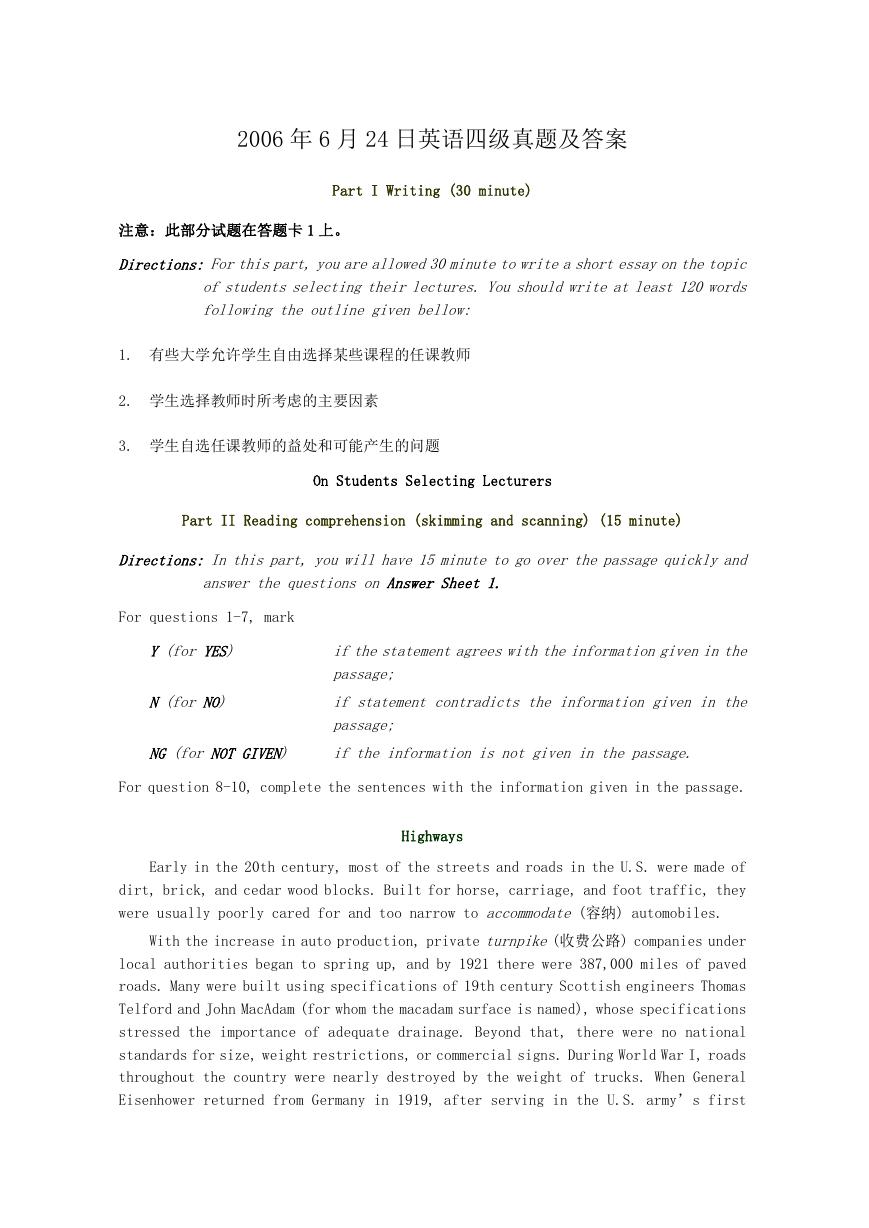
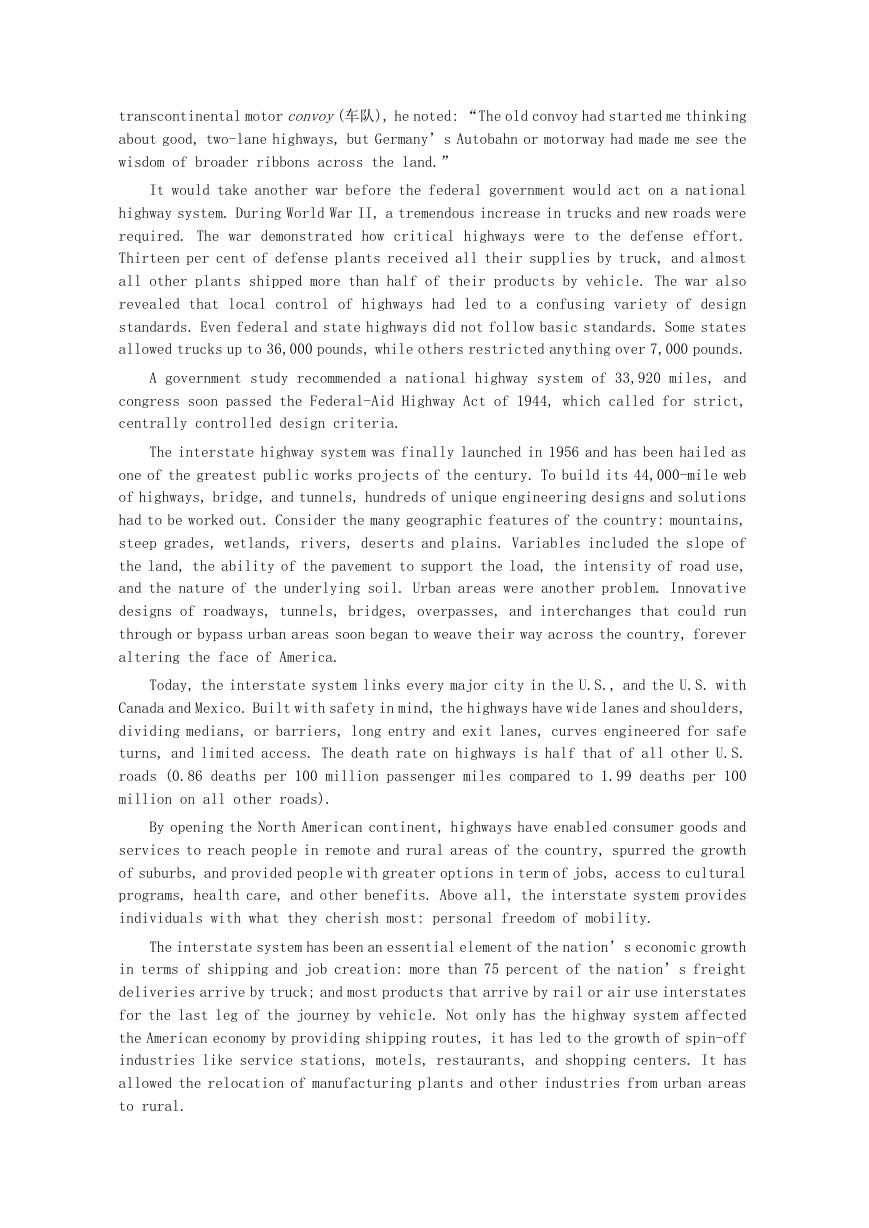
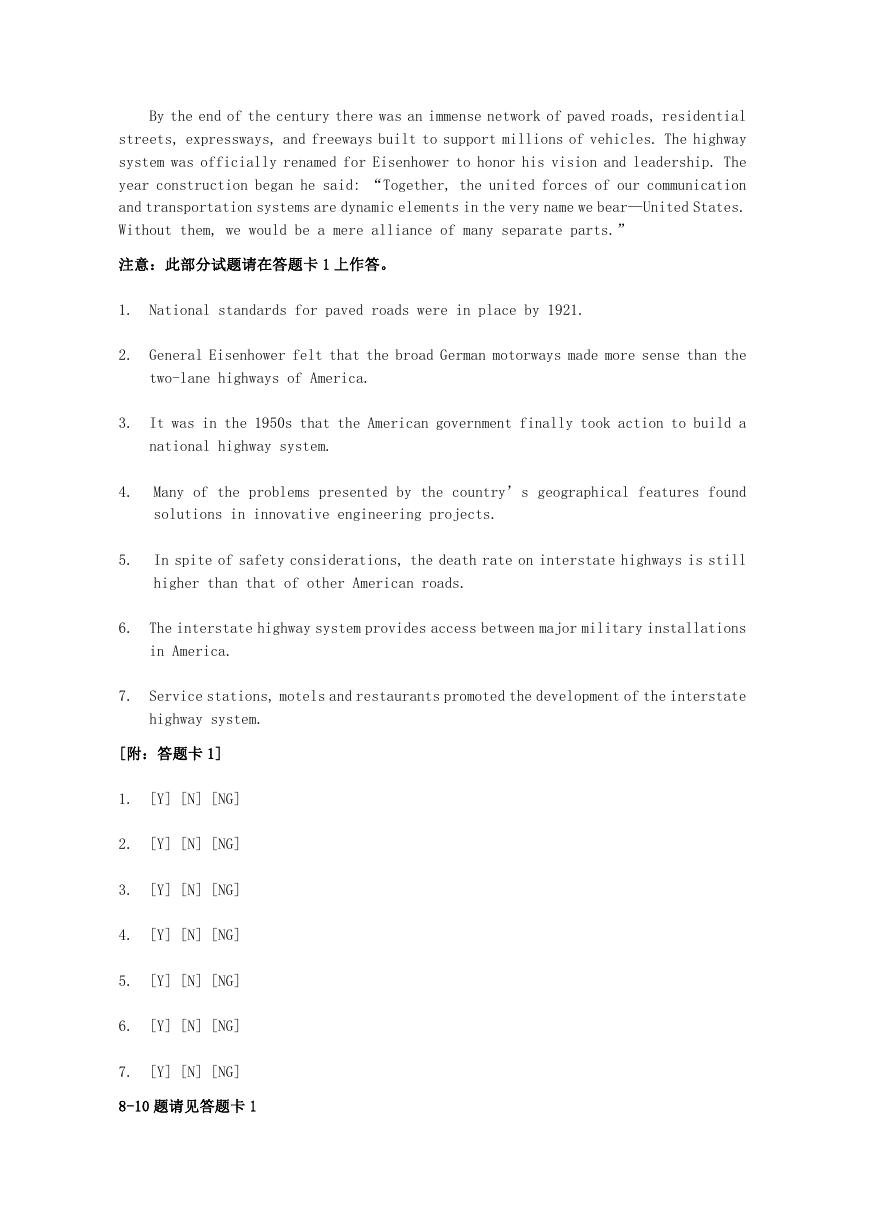
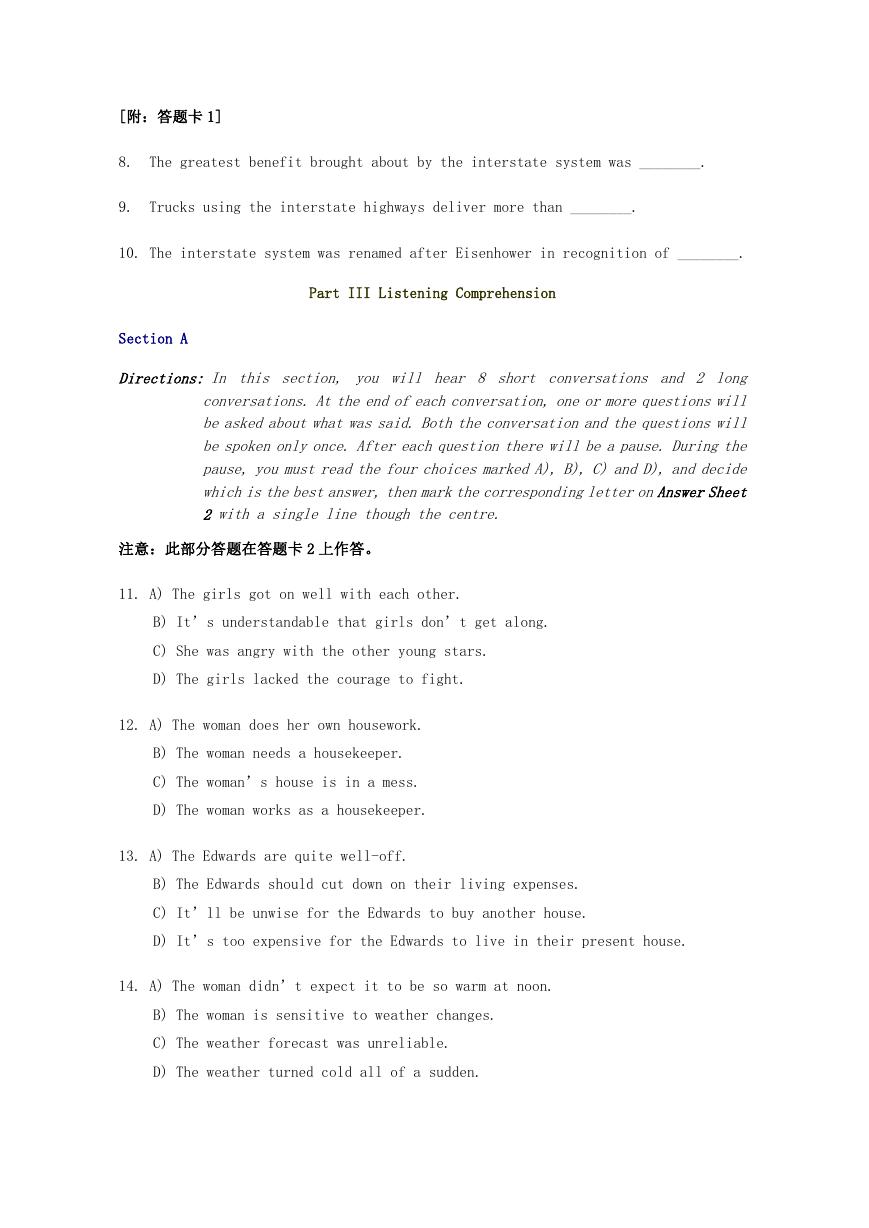
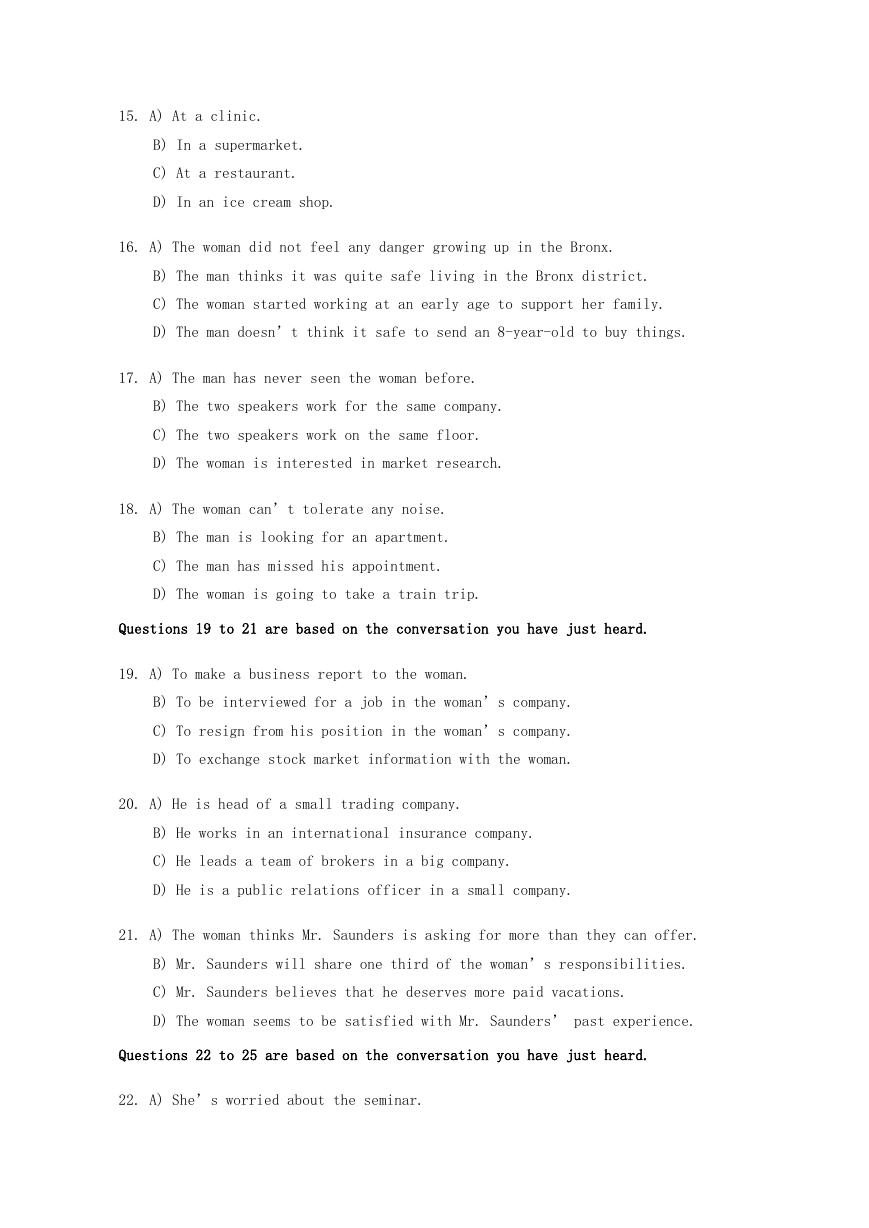


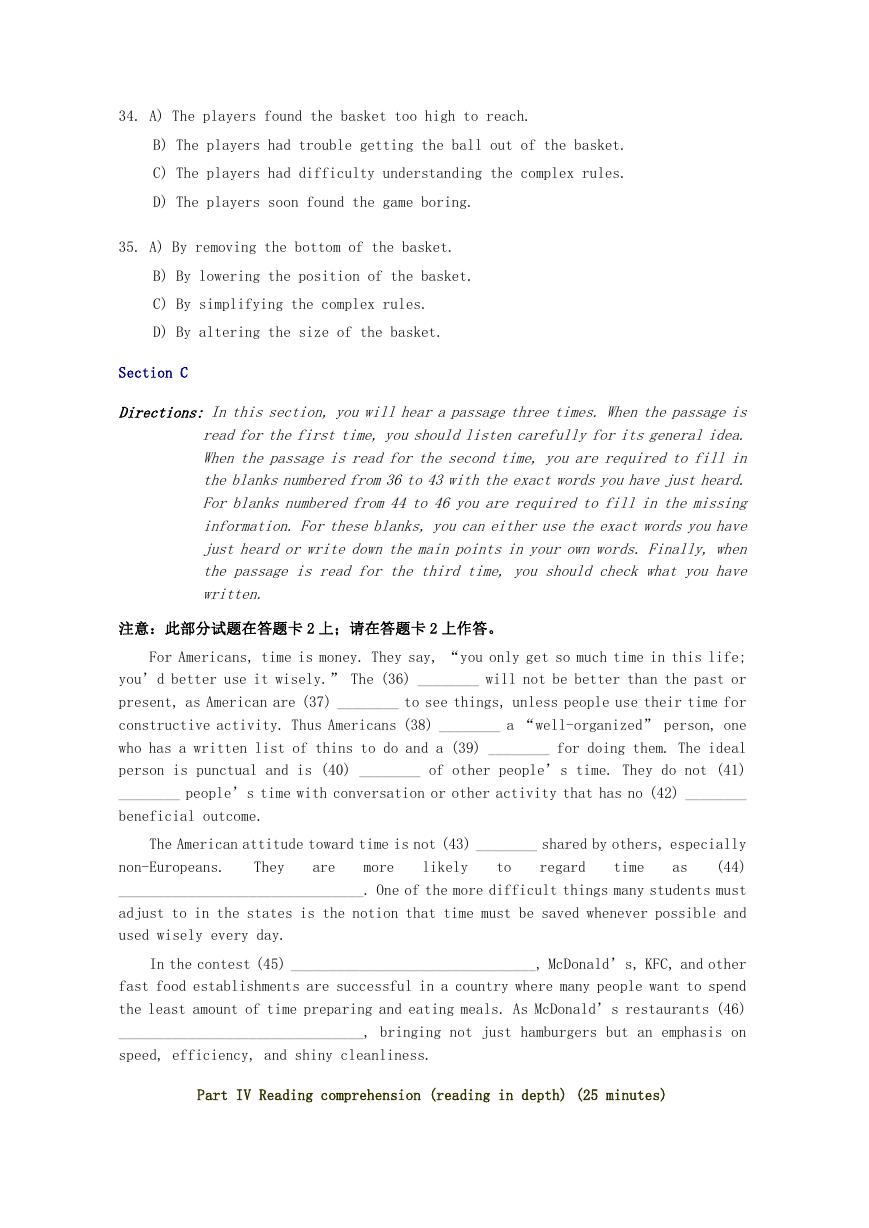








 2023年江西萍乡中考道德与法治真题及答案.doc
2023年江西萍乡中考道德与法治真题及答案.doc 2012年重庆南川中考生物真题及答案.doc
2012年重庆南川中考生物真题及答案.doc 2013年江西师范大学地理学综合及文艺理论基础考研真题.doc
2013年江西师范大学地理学综合及文艺理论基础考研真题.doc 2020年四川甘孜小升初语文真题及答案I卷.doc
2020年四川甘孜小升初语文真题及答案I卷.doc 2020年注册岩土工程师专业基础考试真题及答案.doc
2020年注册岩土工程师专业基础考试真题及答案.doc 2023-2024学年福建省厦门市九年级上学期数学月考试题及答案.doc
2023-2024学年福建省厦门市九年级上学期数学月考试题及答案.doc 2021-2022学年辽宁省沈阳市大东区九年级上学期语文期末试题及答案.doc
2021-2022学年辽宁省沈阳市大东区九年级上学期语文期末试题及答案.doc 2022-2023学年北京东城区初三第一学期物理期末试卷及答案.doc
2022-2023学年北京东城区初三第一学期物理期末试卷及答案.doc 2018上半年江西教师资格初中地理学科知识与教学能力真题及答案.doc
2018上半年江西教师资格初中地理学科知识与教学能力真题及答案.doc 2012年河北国家公务员申论考试真题及答案-省级.doc
2012年河北国家公务员申论考试真题及答案-省级.doc 2020-2021学年江苏省扬州市江都区邵樊片九年级上学期数学第一次质量检测试题及答案.doc
2020-2021学年江苏省扬州市江都区邵樊片九年级上学期数学第一次质量检测试题及答案.doc 2022下半年黑龙江教师资格证中学综合素质真题及答案.doc
2022下半年黑龙江教师资格证中学综合素质真题及答案.doc